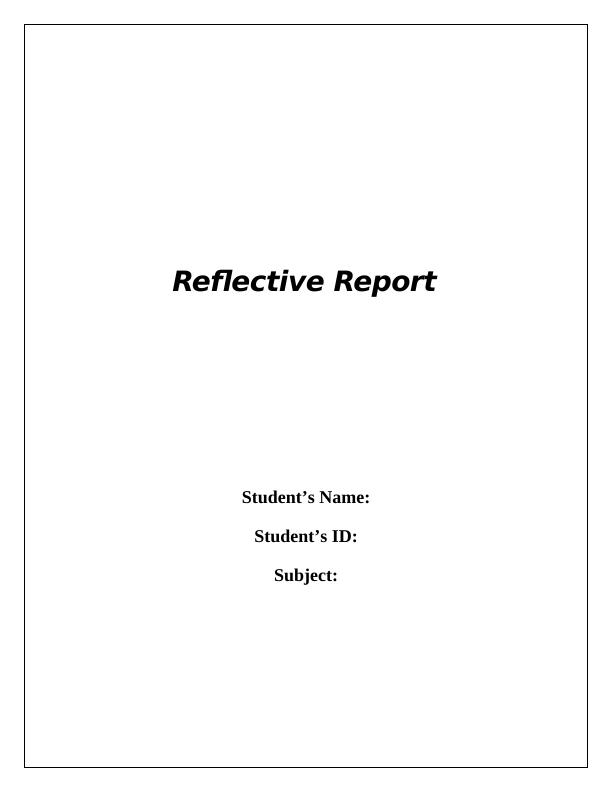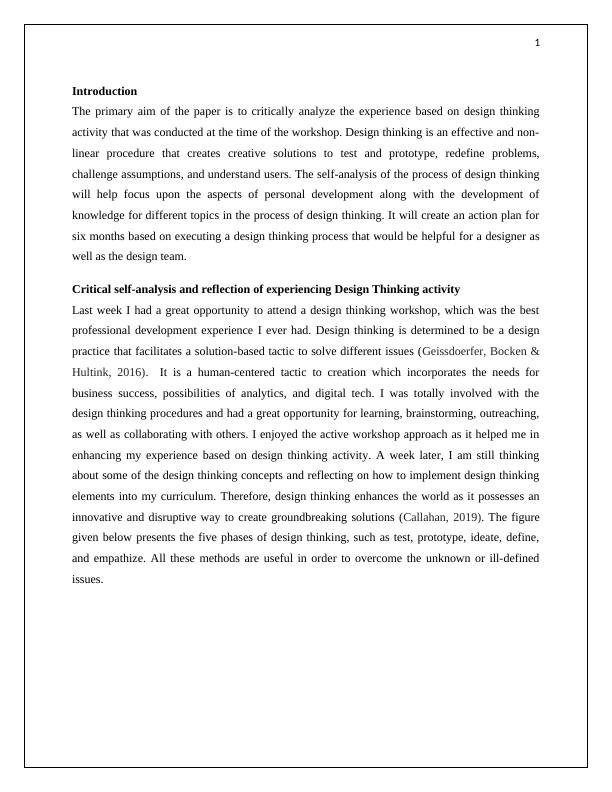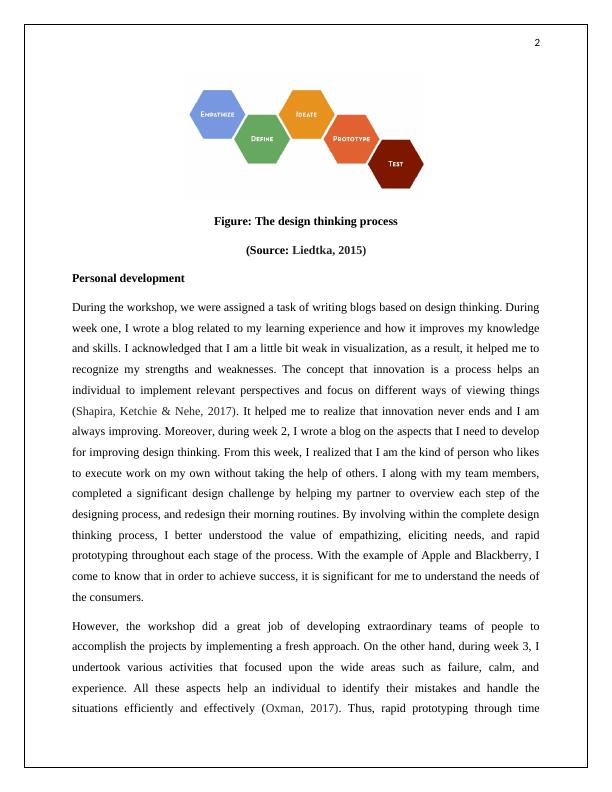Reflective Report on Design Thinking Workshop
Design the (Learning) Launch Workshop and outline the learning objectives.
13 Pages3235 Words181 Views
Added on 2023-03-30
About This Document
This reflective report analyzes the experience of a design thinking workshop, focusing on personal development, knowledge development, and an action plan for the next six months.
Reflective Report on Design Thinking Workshop
Design the (Learning) Launch Workshop and outline the learning objectives.
Added on 2023-03-30
ShareRelated Documents
Reflective Report
Student’s Name:
Student’s ID:
Subject:
Student’s Name:
Student’s ID:
Subject:

1
Introduction
The primary aim of the paper is to critically analyze the experience based on design thinking
activity that was conducted at the time of the workshop. Design thinking is an effective and non-
linear procedure that creates creative solutions to test and prototype, redefine problems,
challenge assumptions, and understand users. The self-analysis of the process of design thinking
will help focus upon the aspects of personal development along with the development of
knowledge for different topics in the process of design thinking. It will create an action plan for
six months based on executing a design thinking process that would be helpful for a designer as
well as the design team.
Critical self-analysis and reflection of experiencing Design Thinking activity
Last week I had a great opportunity to attend a design thinking workshop, which was the best
professional development experience I ever had. Design thinking is determined to be a design
practice that facilitates a solution-based tactic to solve different issues (Geissdoerfer, Bocken &
Hultink, 2016). It is a human-centered tactic to creation which incorporates the needs for
business success, possibilities of analytics, and digital tech. I was totally involved with the
design thinking procedures and had a great opportunity for learning, brainstorming, outreaching,
as well as collaborating with others. I enjoyed the active workshop approach as it helped me in
enhancing my experience based on design thinking activity. A week later, I am still thinking
about some of the design thinking concepts and reflecting on how to implement design thinking
elements into my curriculum. Therefore, design thinking enhances the world as it possesses an
innovative and disruptive way to create groundbreaking solutions (Callahan, 2019). The figure
given below presents the five phases of design thinking, such as test, prototype, ideate, define,
and empathize. All these methods are useful in order to overcome the unknown or ill-defined
issues.
Introduction
The primary aim of the paper is to critically analyze the experience based on design thinking
activity that was conducted at the time of the workshop. Design thinking is an effective and non-
linear procedure that creates creative solutions to test and prototype, redefine problems,
challenge assumptions, and understand users. The self-analysis of the process of design thinking
will help focus upon the aspects of personal development along with the development of
knowledge for different topics in the process of design thinking. It will create an action plan for
six months based on executing a design thinking process that would be helpful for a designer as
well as the design team.
Critical self-analysis and reflection of experiencing Design Thinking activity
Last week I had a great opportunity to attend a design thinking workshop, which was the best
professional development experience I ever had. Design thinking is determined to be a design
practice that facilitates a solution-based tactic to solve different issues (Geissdoerfer, Bocken &
Hultink, 2016). It is a human-centered tactic to creation which incorporates the needs for
business success, possibilities of analytics, and digital tech. I was totally involved with the
design thinking procedures and had a great opportunity for learning, brainstorming, outreaching,
as well as collaborating with others. I enjoyed the active workshop approach as it helped me in
enhancing my experience based on design thinking activity. A week later, I am still thinking
about some of the design thinking concepts and reflecting on how to implement design thinking
elements into my curriculum. Therefore, design thinking enhances the world as it possesses an
innovative and disruptive way to create groundbreaking solutions (Callahan, 2019). The figure
given below presents the five phases of design thinking, such as test, prototype, ideate, define,
and empathize. All these methods are useful in order to overcome the unknown or ill-defined
issues.

2
Figure: The design thinking process
(Source: Liedtka, 2015)
Personal development
During the workshop, we were assigned a task of writing blogs based on design thinking. During
week one, I wrote a blog related to my learning experience and how it improves my knowledge
and skills. I acknowledged that I am a little bit weak in visualization, as a result, it helped me to
recognize my strengths and weaknesses. The concept that innovation is a process helps an
individual to implement relevant perspectives and focus on different ways of viewing things
(Shapira, Ketchie & Nehe, 2017). It helped me to realize that innovation never ends and I am
always improving. Moreover, during week 2, I wrote a blog on the aspects that I need to develop
for improving design thinking. From this week, I realized that I am the kind of person who likes
to execute work on my own without taking the help of others. I along with my team members,
completed a significant design challenge by helping my partner to overview each step of the
designing process, and redesign their morning routines. By involving within the complete design
thinking process, I better understood the value of empathizing, eliciting needs, and rapid
prototyping throughout each stage of the process. With the example of Apple and Blackberry, I
come to know that in order to achieve success, it is significant for me to understand the needs of
the consumers.
However, the workshop did a great job of developing extraordinary teams of people to
accomplish the projects by implementing a fresh approach. On the other hand, during week 3, I
undertook various activities that focused upon the wide areas such as failure, calm, and
experience. All these aspects help an individual to identify their mistakes and handle the
situations efficiently and effectively (Oxman, 2017). Thus, rapid prototyping through time
Figure: The design thinking process
(Source: Liedtka, 2015)
Personal development
During the workshop, we were assigned a task of writing blogs based on design thinking. During
week one, I wrote a blog related to my learning experience and how it improves my knowledge
and skills. I acknowledged that I am a little bit weak in visualization, as a result, it helped me to
recognize my strengths and weaknesses. The concept that innovation is a process helps an
individual to implement relevant perspectives and focus on different ways of viewing things
(Shapira, Ketchie & Nehe, 2017). It helped me to realize that innovation never ends and I am
always improving. Moreover, during week 2, I wrote a blog on the aspects that I need to develop
for improving design thinking. From this week, I realized that I am the kind of person who likes
to execute work on my own without taking the help of others. I along with my team members,
completed a significant design challenge by helping my partner to overview each step of the
designing process, and redesign their morning routines. By involving within the complete design
thinking process, I better understood the value of empathizing, eliciting needs, and rapid
prototyping throughout each stage of the process. With the example of Apple and Blackberry, I
come to know that in order to achieve success, it is significant for me to understand the needs of
the consumers.
However, the workshop did a great job of developing extraordinary teams of people to
accomplish the projects by implementing a fresh approach. On the other hand, during week 3, I
undertook various activities that focused upon the wide areas such as failure, calm, and
experience. All these aspects help an individual to identify their mistakes and handle the
situations efficiently and effectively (Oxman, 2017). Thus, rapid prototyping through time

3
constraints helped me in creating new and innovative ideas and how to involve as a collaborator
in the process of building. Therefore, I also realized that in the future, I need to practice how to
overcome problems like social or political life, remaining calm in difficult situations and
managing the failure. Whereas, during week 4, I wrote about the positive and negative
experiences that I faced in my workplace. It is significant for an individual to manage the
organizational activities effectively either in a good or bad situation. Thus, with the help of the
well-developed platform, I learned how to solve problems and build an empathetic nature.
Moreover, during week 5, I learned the design thinking process, which is all about creativity and
imagination. I also learned regarding various rules of brainstorming that helped me to change my
perspective and apply the design thinking process in different situations. The activities conducted
in this week motivated me to make mistakes, feel safe, and fail forward where I celebrated the
normalized failure and mistakes as a part of the learning process. These particular activities help
an individual to develop their behavior, skills, and knowledge. The workshop also helped me to
think about various aspects such as what I do, why I do, and how I do. Engaging in the activities
based on design thinking conducted over the workshop was a unique experience for me as it
inspired me to think about others.
The use of different tools, artifacts, and activities in the design thinking process helps in
recognizing the challenges as well as benefits of resources. The activities and tools are
considered to be a significant process that is used to conduct a workshop (Stephens & Boland,
2015). Hence, the representation and documentation that has been implemented throughout the
workshop are useful for me in creating new ideas and solving problems. However, the activities
that were held developed a safe space for failure that plays a vital role in an effective design
procedure. The design thinking process possesses several intuitive practices that create a
powerful too (Glen, Suciu, Baughn & Anson, 2015). This experience would help me in the future
to develop innovative approaches while designing products or services for customers.
constraints helped me in creating new and innovative ideas and how to involve as a collaborator
in the process of building. Therefore, I also realized that in the future, I need to practice how to
overcome problems like social or political life, remaining calm in difficult situations and
managing the failure. Whereas, during week 4, I wrote about the positive and negative
experiences that I faced in my workplace. It is significant for an individual to manage the
organizational activities effectively either in a good or bad situation. Thus, with the help of the
well-developed platform, I learned how to solve problems and build an empathetic nature.
Moreover, during week 5, I learned the design thinking process, which is all about creativity and
imagination. I also learned regarding various rules of brainstorming that helped me to change my
perspective and apply the design thinking process in different situations. The activities conducted
in this week motivated me to make mistakes, feel safe, and fail forward where I celebrated the
normalized failure and mistakes as a part of the learning process. These particular activities help
an individual to develop their behavior, skills, and knowledge. The workshop also helped me to
think about various aspects such as what I do, why I do, and how I do. Engaging in the activities
based on design thinking conducted over the workshop was a unique experience for me as it
inspired me to think about others.
The use of different tools, artifacts, and activities in the design thinking process helps in
recognizing the challenges as well as benefits of resources. The activities and tools are
considered to be a significant process that is used to conduct a workshop (Stephens & Boland,
2015). Hence, the representation and documentation that has been implemented throughout the
workshop are useful for me in creating new ideas and solving problems. However, the activities
that were held developed a safe space for failure that plays a vital role in an effective design
procedure. The design thinking process possesses several intuitive practices that create a
powerful too (Glen, Suciu, Baughn & Anson, 2015). This experience would help me in the future
to develop innovative approaches while designing products or services for customers.

End of preview
Want to access all the pages? Upload your documents or become a member.
Related Documents
Problem-solving approachlg...
|12
|2864
|402
Reflective Report on Design Thinkinglg...
|13
|3082
|253
Design Thinking and Innovationlg...
|11
|2991
|244
Innovation and Thinkinglg...
|13
|3332
|27
Design Thinking.lg...
|14
|3552
|7
Assignment on Design Thinking Conceptlg...
|12
|2251
|47
